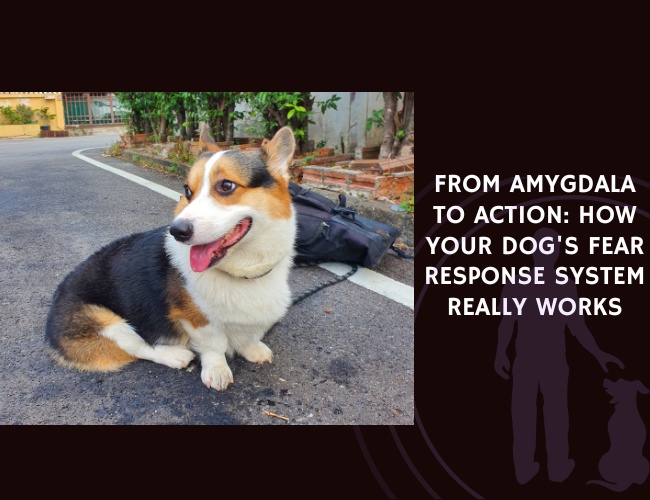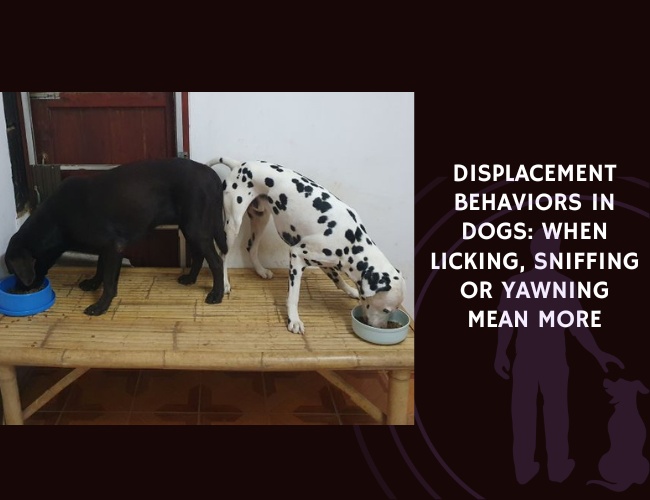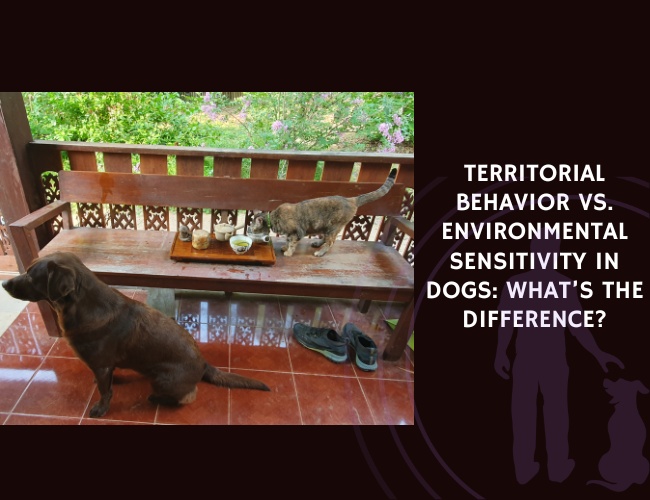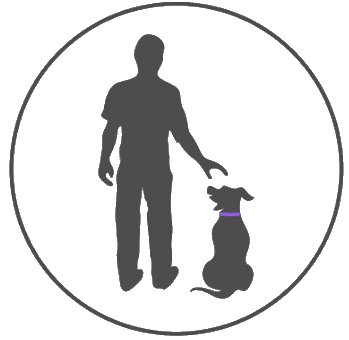Understanding Fear: A Survival Mechanism
Fear is a deeply-rooted emotional response that acts as a protective mechanism, helping dogs to navigate the various dangers that can arise in their environment. Understanding this response can improve the welfare of our canine companions and enhance their interactions with humans and other animals. In this chapter, we’ll explore what fear is, distinguish between normal fear and phobias, and examine the evolutionary purpose of fear in canine survival.
Definition of Fear as an Adaptive Emotional Response
Fear is a natural and adaptive emotional response to perceived threats or dangers. It serves as a vital survival tool for dogs, prompting them to engage in behaviors that protect them from harm. When a dog senses danger, their fear response kicks in, triggering actions that can help avert the threat. This response is part of the dog’s instincts, finely tuned over thousands of years through evolution and natural selection.
Difference Between Normal Fear and Phobias
Normal Fear
Normal fear is a proportionate response to an actual threat. For instance, a dog might experience fear during a thunderstorm, prompting it to seek shelter or comfort. This fear is short-lived and dissipates once the threat has passed, helping the dog to stay safe without causing long-term distress.
Phobias
Phobias, on the other hand, are exaggerated, irrational fears that persist even when there is no real danger. They can lead to significant distress and impair a dog’s daily functioning. A dog with a noise phobia might react to common, everyday sounds (like a dropped spoon) with panic, even when there is no actual threat. This type of fear can be debilitating and often requires professional intervention to manage.
Evolutionary Purpose in Canine Survival
The primary evolutionary purpose of fear is to enhance survival by triggering quick reactions to potential dangers. These responses fall into several categories:
- Fight: Confronting the threat with aggression.
- Flight: Escaping from the danger swiftly.
- Freeze: Staying still to avoid detection.
- Appeasement: Displaying submissive behaviors to reduce conflict.
These behaviors have been vital in helping dogs, both wild and domestic, avoid predators and other dangers in their environment. For example, a flight response can help a dog quickly leave a threatening situation, increasing its chances of survival.
Additionally, fear responses can also act as an evolutionary “leftover,” leading to reactions in situations that might not be immediately threatening in a modern, domestic context. For instance, a dog might exhibit fear during a fireworks display even though there is no direct threat. This shows how ancient survival mechanisms are still active in today’s dogs.
Understanding these aspects of fear helps us appreciate why dogs react the way they do and underscores the importance of managing and mitigating fear responses, particularly chronic or phobic ones, to ensure the health and well-being of our pets.
Continuing to delve deeper will reveal the physiological and neurological aspects of how dogs process fear, providing further insight into their complex emotional lives.
The Brain’s Fear Circuit
Role of Amygdala in Processing Fear Signals
The amygdala is a small, almond-shaped structure nestled deep within your dog’s brain. It’s central to how fear is processed. When your dog senses something scary, like a loud noise or a strange object, the amygdala steps in to assess the situation. It takes these sensory inputs from the environment and decides if a fear response is necessary. If your dog determines there’s a threat, the amygdala triggers the stress response, signaling the rest of the brain and body to prepare for action.
Hypothalamus and Autonomic Nervous System Activation
Once the amygdala sounds the alarm, the hypothalamus springs into action. This region of the brain regulates the autonomic nervous system, which controls involuntary functions like heart rate and respiration. The hypothalamus activates the sympathetic nervous system, prompting the well-known fight-or-flight response. This means your dog might get ready to either confront the threat or make a speedy escape.
The hypothalamus instructs the adrenal glands to release adrenaline (epinephrine), leading to various physiological changes. Your dog’s heart rate increases, pupils dilate, and muscles prepare for quick movement. This state of heightened alertness is all about ensuring survival, whether that means running away from a perceived threat or standing ground to face it.
Prefrontal Cortex’s Role in Threat Assessment
While the amygdala and hypothalamus handle the immediate emergency response, the prefrontal cortex (PFC) plays a more strategic role. This part of the brain is involved in higher-level thinking and decision-making. The PFC assesses the situation more thoroughly, helping your dog determine if the threat is real and how best to respond.
The PFC can modulate the fear response initiated by the amygdala, ensuring that your dog doesn’t overreact to every potential danger. For instance, if the PFC concludes that the strange noise is just a harmless household sound, it can work to calm the initial fear response. This intricate balance helps your dog navigate the world by differentiating between actual threats and benign stimuli.
Understanding the roles of the amygdala, hypothalamus, and prefrontal cortex in processing fear is crucial for helping our canine companions manage their emotions. Recognizing how these brain structures contribute to your dog’s fear response can aid in addressing and mitigating anxiety-related behaviors.
Realizing how interconnected and complex these systems are can open the door to more effective strategies for helping dogs cope with fear. This knowledge underscores the importance of creating supportive environments for our furry friends.
Chemical Messengers of Fear
Fear is more than just a psychological experience. It’s rooted deeply in our biology, mediated by a sophisticated network of chemical messengers. In this chapter, we will explore the roles of cortisol and adrenaline, and the impact of neurotransmitters in fear processing.
Cortisol: The Primary Stress Hormone
Cortisol is often referred to as the body’s primary stress hormone. When your dog encounters a frightening situation, the hypothalamus sends a signal to the pituitary gland, which in turn signals the adrenal glands to release cortisol. This hormone prepares the body to either confront the danger (fight) or run away (flight).
- Energy Release: Cortisol increases glucose in the bloodstream, supplying immediate energy to muscles.
- Immune System Suppression: While it enhances short-term survival, prolonged elevated cortisol levels can suppress the immune system, making your dog more susceptible to infections and illness.
- Behavioral Indicators: Elevated cortisol levels are often associated with behaviors such as excessive barking, pacing, or even aggression.
Adrenaline’s Effects on Body Preparation
Adrenaline, also known as epinephrine, is another critical player in the body’s acute stress response. Released by the adrenal glands, adrenaline works quickly to prepare the body for imminent action.
- Cardiovascular Impact: Adrenaline increases heart rate and blood pressure, directing more blood to major muscle groups. This helps your dog be ready to react swiftly, whether to flee or fight.
- Enhanced Alertness: The hormone sharpens your dog’s senses, dilating pupils and enhancing focus.
- Immediate Effects: Unlike cortisol, which works over minutes to hours, adrenaline has almost immediate effects, enabling rapid responses to perceived threats.

Impact of Neurotransmitters on Fear Processing
Neurotransmitters are chemical messengers that relay signals across neurons in the brain, significantly influencing fear responses.
- Dopamine: Often associated with reward and pleasure, dopamine also plays a role in fear. It helps in reinforcing and remembering the responses to fearful stimuli, ensuring faster reactions in future similar situations.
- Serotonin: Known for regulating mood and anxiety, serotonin levels can affect how fear is processed. Low serotonin levels are often linked to heightened anxiety and fearfulness.
- Gamma-Aminobutyric Acid (GABA): This inhibitory neurotransmitter helps to calm the nervous system down post-threat, reducing anxiety and restoring balance.
Understanding the chemical messengers of fear can help in managing and alleviating unnecessary stress in dogs. Recognizing how cortisol, adrenaline, and various neurotransmitters work provides critical insights into the physiological changes that accompany fear and how these can affect your dog’s overall well-being. By monitoring for signs of chronic fear and addressing them early, owners can significantly improve their dog’s quality of life.
As we dive deeper into understanding fear in dogs, it’s important to recognize the physical and behavioral signals of fear that they exhibit. Let’s explore these indicators further to better identify and address our pets’ needs.
Reading Your Dog’s Fear Signals
Understanding your dog’s fear signals is crucial for ensuring their well-being. Dogs can exhibit fear through various physical and behavioral signs, and these may vary in intensity from mild to severe. There are numerous common triggers and environmental factors that might influence a dog’s fear response. Recognizing these signs early can help manage your dog’s fear effectively.
Physical Signs
Physical signs are often the first indicators that your dog is experiencing fear. Keep an eye out for these common physical manifestations:
- Heart Rate: An increase in heart rate is a clear indicator of fear. While you may not be able to feel their heartbeat directly, you might notice your dog’s rapid breathing or panting.
- Trembling: One of the most visible signs of fear in dogs is trembling or shivering. This can occur even if they are not cold and often happens in response to a specific trigger.
- Dilated Pupils: When a dog is afraid, their pupils will dilate to take in more of their surroundings as part of the fight-or-flight response.
- Ears and Tail Position: A fearful dog might have their ears flattened against their head and their tail tucked between their legs.
- Body Stiffness: A dog in fear may become very tense or rigid.
Behavioral Manifestations
Dogs exhibit a broad range of behaviors when they are scared. These behaviors can range from mild to severe:
- Mild Fear Responses:
- Cowering
- Avoiding eye contact
- Hiding
- Moderate Responses:
- Barking
- Growling
- Whining
- Attempting to escape
- Severe Responses:
- Aggression (fight response)
- Destructive behaviors
- Complete shutdown (freeze)
Understanding these behaviors can help you gauge the level of fear your dog is experiencing and respond appropriately.
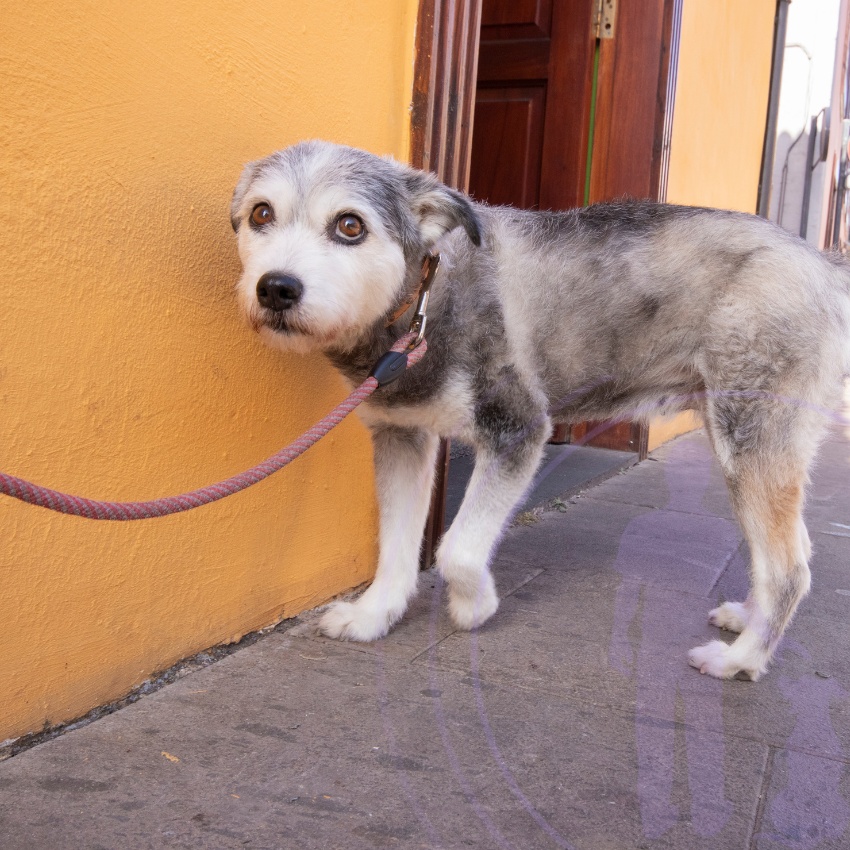
Common Triggers and Environmental Factors
Identifying what triggers your dog’s fear is a key step in managing it. Common triggers include:
- Environmental Stimuli:
- Loud noises such as thunder or fireworks
- Unfamiliar objects or crowded spaces
- Social Factors:
- Fear of unfamiliar people, other dogs, or animals
- Trauma-Related Triggers:
- Abuse, neglect, or lack of socialization during critical developmental periods
- Genetic Predisposition:
- Some breeds or individual dogs might be genetically more anxious or fearful, which can influence their responses.
Recognizing these triggers can help in avoiding or reducing exposure to them, thus managing your dog’s fear more effectively.
Learning to read your dog’s fear signals not only improves your relationship but also enhances their quality of life. Awareness and early intervention are key to preventing chronic fear and its detrimental effects on your dog’s health and behavior.
Is fearful behavior in dogs learned or innate?
Understanding whether fearful behavior in dogs is learned or innate involves exploring both genetic predispositions and environmental influences. Research indicates that some fears in dogs, such as those triggered by the scent of predators, may be genetically encoded. This suggests an innate component to fear responses, where certain stimuli automatically trigger a fear reaction due to evolutionary survival mechanisms. For instance, the amygdala, a key brain structure involved in processing fear, can activate these responses without prior learning, highlighting the instinctual nature of some fears.
However, not all fear responses are purely innate. Dogs also learn to fear through experiences, which means that their environment plays a significant role in shaping their reactions. A dog that has had negative encounters with strangers or loud noises may develop learned fears associated with those stimuli. This learned aspect of fear is evident when dogs associate specific cues, like a thunderstorm, with past distressing events, leading to anxiety even in the absence of immediate danger. Thus, while some fears are hardwired into a dog’s genetic makeup, others are acquired through life experiences, creating a complex interplay between innate and learned behaviors.
The distinction between learned and innate fear responses in dogs underscores the importance of understanding individual differences in canine behavior. Recognizing that some dogs may be more genetically predisposed to fear can guide owners and trainers in developing tailored strategies to manage and mitigate these responses. By combining knowledge of genetic influences with behavioral training techniques, such as desensitization and counterconditioning, we can help dogs overcome irrational fears and improve their overall well-being.
When Fear Becomes Chronic
Impact on Physical Health and Immune Function
When fear becomes chronic in dogs, it can have far-reaching effects, impacting not just their mental state but also their physical health. Chronic stress caused by persistent fear leads to prolonged release of stress hormones such as cortisol, which, while useful in short bursts for survival, can be highly detrimental over time.
Dogs experiencing chronic fear often display symptoms like [weight loss, gastrointestinal issues, and a weakened immune system]. The constant elevated cortisol levels can suppress immune function, making dogs more susceptible to illnesses and infections.
Behavioral Consequences and Quality of Life
Chronic fear also significantly influences dogs‘ behavior and overall quality of life. One of the significant behavioral impacts is the development of anxiety disorders, which can manifest as obsessive behaviors, such as excessive licking or chewing, and heightened reactivity to new or changing environments.
Fearful dogs may exhibit aggressive behaviors due to their heightened state of stress. This aggression often stems from a place of fear and anxiety rather than dominance or anger. These dogs may become overprotective of their resources or space, leading to biting or growling incidents.
The quality of life for dogs living in constant fear is notably diminished. They might avoid activities they previously enjoyed, exhibit signs of depression, or fail to form healthy social bonds with other dogs or humans. Such chronic avoidance behaviors indicate that the dog is not coping well with its fear, which can lead to an overall decline in its well-being.
Signs Indicating the Need for Professional Intervention
It’s essential to recognize when a dog’s fear has escalated to a point where professional help is needed. Persistent fear that affects the dog’s daily life, especially when no clear triggers are present, is a sign that intervention may be required. Other indicators include:
- Persistent Fear with No Clear Cause: This can signify underlying health issues or deeply ingrained trauma.
- Aggressive Behaviors Linked to Fear: If a dog begins showing aggression related to their fear, it’s crucial to seek help to prevent harm to themselves or others.
- Failure to Recover from Stressful Situations: If your dog remains anxious long after a stressful event has passed, this is a red flag.
When professional intervention is indicated, it may involve working with a veterinarian or a certified animal behaviorist. They can provide a comprehensive assessment and tailor a treatment plan that includes techniques like desensitization, counterconditioning, and potentially medication to help manage the dog’s chronic fear.
By understanding and addressing the chronic fear in dogs, we can greatly enhance their physical and emotional health, and improve their overall quality of life.

Managing and Preventing Fear
When it comes to managing and preventing fear in our beloved canine companions, a proactive and informed approach is key. This chapter delves into effective techniques and strategies to help your dog overcome fear, ensuring a happier and healthier life.
Desensitization and Counterconditioning Techniques
Two of the most effective methods for managing fear in dogs are desensitization and counterconditioning. These techniques involve gradually exposing your dog to the fear trigger while creating positive associations, ultimately reducing the fear response.
- Desensitization: This involves gradually introducing your dog to the fear-inducing stimulus at a low intensity that does not elicit a fear response. Over time, the intensity is slowly increased while ensuring your dog remains comfortable. For instance, if your dog is afraid of loud noises, start with very low-volume recordings and gradually increase the volume as your dog becomes more accustomed to the sound.
- Counterconditioning: This technique aims to change your dog’s emotional response by associating the fear trigger with something positive. For example, if your dog is fearful of strangers, you can offer treats or play with a favorite toy whenever a stranger is nearby. Over time, your dog will begin to associate the presence of strangers with positive experiences.
Combining these techniques can be highly effective in reducing fear in dogs. Patience, consistency, and plenty of positive reinforcement are essential for success.
Environmental Management Strategies
Adjustments to your dog’s environment can significantly impact their fear levels. Creating a safe and supportive space can help your dog feel secure and reduce their stress.
- Safe Space: Designate a quiet, comforting area for your dog, such as a crate or a cozy corner in a room. This safe space can serve as a retreat during stressful situations.
- Calming Aids: Tools such as Thundershirts, which provide gentle, constant pressure, and calming pheromone diffusers can help soothe anxious dogs. White noise machines can also minimize the impact of loud noises that may trigger fear responses.
- Routine and Predictability: Maintaining a consistent routine helps provide a sense of stability and predictability, which can be comforting to a fearful dog. Try to keep feeding, walking, and playtime schedules as regular as possible.
- Avoiding Triggers: When feasible, minimize your dog’s exposure to known fear triggers. For instance, if your dog is afraid of fireworks, create a soundproofed area during events that involve loud noises.
Importance of Early Socialization in Puppies
Early socialization plays a crucial role in preventing fear development in dogs. Exposing puppies to a variety of experiences during their critical socialization period (from 3 to 14 weeks of age) can help build confidence and resilience.
- Exposure to Different Stimuli: Introduce your puppy to a range of environments, sounds, people, and other dogs. Positive experiences during this period can help your puppy develop into a well-adjusted adult dog.
- Positive Reinforcement: Encourage and reward positive behaviors in new situations. Use treats, praise, and play to create positive associations with unfamiliar experiences.
- Controlled Experiences: Ensure that the new experiences are positive and controlled. Overwhelming your puppy can have the opposite effect, so introduce new things gradually and in a calm manner.
- Socialization Classes: Puppy socialization classes provide structured and supervised environments where puppies can interact with others and learn appropriate behaviors.
By implementing these strategies and investing time in early socialization, you can lay a solid foundation for your dog’s emotional well-being and prevent the development of irrational fears.
As we strive to understand and help our canine companions navigate their fears, we uncover more about their complex emotional world. Stay tuned for more insights on the exciting advancements and potential future directions linked to canine fear and anxiety research.
Future Frontiers in Fear Research
Emerging Studies on Gut-Brain Connection
Recent studies have highlighted the significant impact of the gut-brain axis on canine fear responses. The gut-brain axis refers to the bidirectional communication between the gastrointestinal tract and the central nervous system. Research indicates that gut health can influence anxiety and fear responses in dogs. Gut microbiota, the microorganisms living in the digestive tracts, play an essential role in this connection. Imbalances in these microbiota can lead to alterations in behavior, including heightened fear and anxiety responses.
For instance, studies involving probiotics have shown promising results in reducing stress-related behaviors. Probiotics, a type of beneficial bacteria, can help maintain a healthy gut microbiome, possibly leading to improved mental health and reduced fearfulness in dogs. This area of research is still in its early stages, but it opens up new potential therapeutic strategies for managing canine fear by targeting gut health.
Breed-Specific Fear Response Patterns
Just as there are breed-specific traits in physical appearance and behavior, certain fear response patterns may also be influenced by a dog’s genetic makeup. Some breeds are naturally more anxious or sensitive to environmental stressors. Understanding these genetic predispositions can help tailor fear management strategies to individual dogs more effectively.
For example:
- Herding Breeds: Dogs like Border Collies and Australian Shepherds are known for their heightened sensitivity and alertness. This makes them more prone to fear responses triggered by novel stimuli.
- Toy Breeds: Smaller breeds, such as Chihuahuas, often exhibit stronger fear reactions to changes in their environment due to their size and perceived vulnerability.
By recognizing and studying these breed-specific patterns, we can develop more personalized approaches to fear management, enhancing the overall well-being of these dogs.
New Therapeutic Approaches Under Investigation
As our understanding of fear mechanisms in dogs grows, new therapeutic approaches are emerging. These methods aim to address fear responses more effectively and improve the quality of life for fearful dogs. Some of these promising therapies include:
- Behavioral Interventions: Traditional techniques like desensitization and counterconditioning are being refined. There’s a growing emphasis on early socialization and positive reinforcement to build resilience against fear-inducing stimuli.
- Pharmacological Treatments: Advances in veterinary medicine are leading to the development of new medications that target the neurological and hormonal pathways involved in fear responses. These medications aim to provide quicker and more sustained relief from severe anxiety and phobias.
- Technological Solutions: Innovations such as wearable sensors can monitor physiological signs of stress in real-time, providing insights into a dog’s emotional state and helping to preemptively address fear triggers.

As this field continues to evolve, these new therapeutic approaches hold promise for significant improvements in the management of fear in dogs, ultimately enhancing their overall quality of life.
As you’ve journeyed from Amygdala to Action, you now understand the intricate dance between your dog’s fear response system and their evolutionary survival mechanism. This knowledge is your secret weapon in decoding your canine companion’s emotional language. So, let’s put this newfound insight into action!
Next time your furry friend shows signs of fear, remember to remain calm and reassuring. They’re not being irrational; they’re simply following their instincts. If you suspect your dog’s fear might be more than a passing storm, don’t hesitate to seek professional help. Together, we can ensure our dogs lead lives that are not only safe but also enriched with love and understanding.
Now, share your newfound wisdom! Let’s raise awareness about the importance of understanding fear in dogs. Leave a comment below about how you’ll apply this knowledge, or share a heartwarming story about your dog overcoming their fears. Let’s build a community of compassionate dog lovers, one tail wag at a time.
And remember, every ‘good boy’ or ‘good girl’ is a step towards strengthening the bond between you and your four-legged friend. Keep learning, keep loving, and keep exploring the amazing world of our canine companions! 🐾💙

